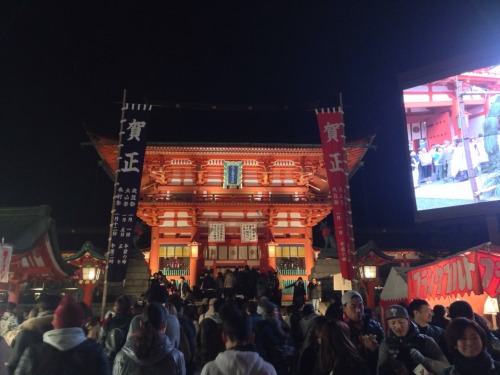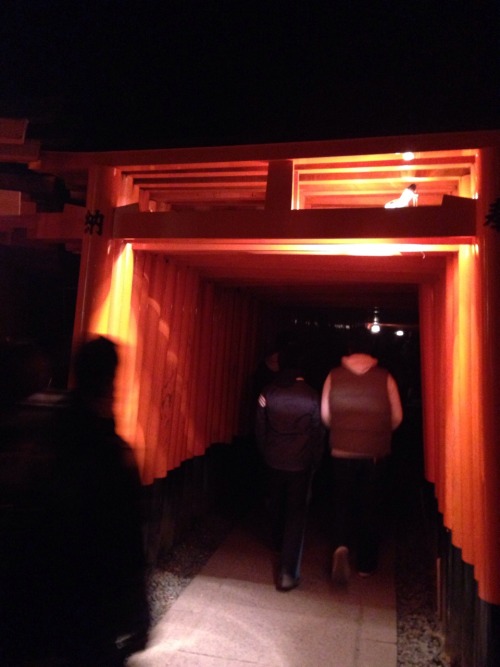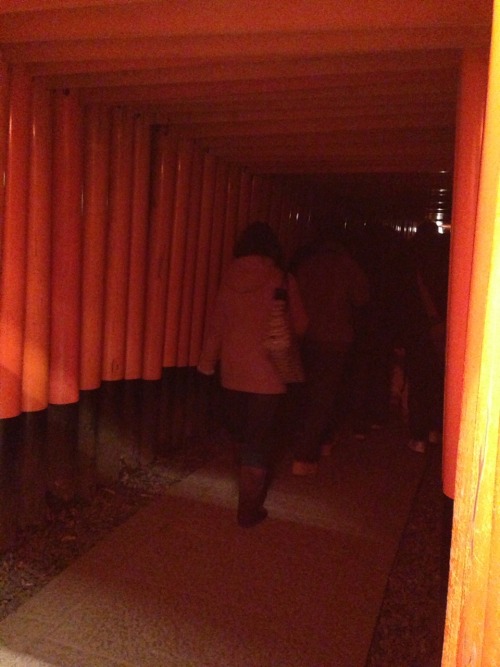#first visit
My first visit of the year to a shrine happened to be Fushimi Inari taisha, Kyoto, which draws the most worshippers in western Japan. It was on our ways home from Kyoto station after countdown concert.
I found a huge, unfamiliar screen by the two-storied gate and it was quite surreal like “Blade Runner” or “Ghost in the Shell”. Is it temporary only for new-year three days?
The approach seemed not crowded as much as new-year daytime, yet before the main hall it was totally stuck and took long time. Further, it was sooooo freezing at three o'clock in the morning to go through thousands of torii gates, back of the main hall, and I decided without hesitation to indulge myself with oden and hot sake as I sooon as I saw at the inner sanctuary. I realized it really worked. Really.
After that, I dropped by the local shrine (ujigami-san: the guardian god of the community) in my neighborhood, obtained new “ofuda (talisman or amulet for home to reach a certain god)” to replace (we do once a year) and got home at five. I have never visited shrines in such early hours of January first. I’ve seen such people only on TV. Unusual fun experience. And I knew myself so tired.
Fushimi Inari shrine
http://www.japan-guide.com/e/e3915.html
https://en.m.wikipedia.org/wiki/Fushimi_Inari-taisha
If it’s daytime, I recommend hiking up to the top of Inari yama mountain (233m above sea level, takes one-two hours to reach as taking photos, reading signboard’s English explanations and having a break at tea house). You will see many little shrines “tsuka” and thousands of torii as enjoying beautiful mountain air and greens. Actually, Inari god (harvest god) was not enshrined at the foot originally and it’s said it still resides in the mountain. So when you go up, be careful of your words and behavior; believe or not, it’s been said the spiritual subordinates here “kitsune (foxes)” to Inari god are very strict to the culpable while they are the most capable and powerful among other kinds.
初詣はたまたま伏見稲荷大社になった。京都駅のカウントダウンライブ後、ちょうど帰宅途中にあったのだ。
行くと楼門前に見慣れない巨大なスクリーンがあり、「ブレードランナー」か「攻殻機動隊」みたいにシュールなことになっていた。あれは正月三ヶ日限定なんだろうか。
参道は正月の昼間ほどには混んでいなかったが、本殿の前は流石に満杯でびたっと詰まっていた。さらに真夜中3時の本殿裏の千本鳥居は無茶苦茶寒くて、奥社奉拝所(おくのやしろほうはいしょ)ではもう、いつもなら食べないおでんと熱燗を目にするや即決で食べていいことに。寒いときのおでんと熱燗はあったまる。それはもう本当に。
その後は家の近所の氏神さんへお詣りして、新しいお札を貰って、朝5時に帰ってきた。夜中のうちに初詣を2件も済ませたのは生まれて初めてだ。そういうのはTVでしか観たことがなかった。なかなか珍しい経験をした。そしてやっばりものすごく眠かった。
伏見稲荷大社
https://ja.m.wikipedia.org/wiki/伏見稲荷大社
昼間であれば稲荷山の頂上まで登って参拝するのがおすすめ(海抜233m、写真を撮ったり立て看板の説明を読んだりお茶屋で休憩したりしながら登って頂上まで1〜2時間)。元々平安時代の頃は麓に社殿はなく稲荷神は山に居ると言われている。道中千本鳥居を始め様々なお社("お塚")があり、空気も清く景色も美しい。地元伏見では頂上の一宮へお参りすることを「お山(やま)する」と言う。・・・お山では狐さん(←厳しい)が見ているのでマナーには注意。
Post link








